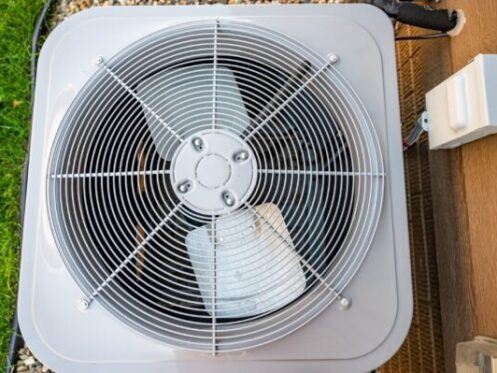The size of an AC unit not only impacts how well your home can be cooled but also influences energy consumption and costs. Determining the correct size of an AC unit involves various factors, including the total square footage of your home and the climate in your region. Today we’ll guide you through finding the optimal AC unit size for your home.
Consider Your Home’s Total Square Footage
When selecting an air conditioning unit, the primary consideration should be the total square footage of your home. The capacity of an air conditioner is typically gauged in terms of its ability to cool, which is quantified in British thermal units (BTUs) or tons. A cooling capacity of 1 ton equates to 12,000 BTUs per hour. Essentially, the size of an AC unit reflects its capability to extract heat from a space in the span of an hour.
To determine the size of an AC unit that you would need, refer to the following guidelines:
- For a home between 600-1,000 square feet, a 1.5-ton unit is recommended. This translates to a cooling capacity of 18,000 BTUs per hour.
- Homes measuring 1,000-1,500 square feet: You’ll need a 2-ton unit, which corresponds to a cooling capacity of 24,000 BTUs per hour.
- Homes measuring 1,500-2,000 square feet: You’ll require a 3-ton unit, equivalent to 36,000 BTUs per hour.
- Homes measuring 2,000-2,500 square feet: A 4-ton unit is necessary.
- Homes measuring 2,500-3,300 square feet: A 5-ton unit is recommended. This unit has an incredible cooling capacity of 60,000 BTUs per hour.
These figures represent a general guideline and can be affected by other factors such as the home’s insulation, number of windows, and local climate. It’s essential to consult with an HVAC professional for a precise calculation to ensure the unit is neither underpowered nor oversized. This balance is vital for optimal comfort, energy efficiency, and longevity of the AC unit.
What Size Air Conditioner Do You Need for a Three Bedroom House?
As a general rule of thumb, you need approximately 1 ton of cooling capacity for every 600-800 square feet. However, this can vary based on factors such as ceiling height and window size and number. For instance, if your three-bedroom house is between 1,500 and 2,000 square feet, you might need a 3-ton air conditioner to cool the space adequately.
However, if the house is poorly insulated or in a particularly hot climate, you might need a larger unit. Conversely, a well-insulated home in cooler weather could get by with a smaller unit. To determine the exact size, it’s recommended to have an HVAC professional conduct a Manual J load calculation. This calculation takes into account all these variables to provide a precise cooling load for your specific house, ensuring you select the right size air conditioner for your needs.
What Happens if Your AC Is Too Small?
If an air conditioning unit is too small for the space it’s meant to cool, several problems can occur, as detailed below.
Inefficiency
An undersized unit will need to work harder and run continuously to try to cool the space to the set temperature. This constant operation can lead to high energy consumption and, consequently, increased utility bills.
Overheating
Because an undersized AC unit has to work continuously, the excessive strain can cause components to overheat. Overheating can lead to mechanical breakdowns and might require frequent, costly repairs or even replacement of the entire unit.
Poor Comfort Levels
A small AC unit won’t be able to adequately cool a large space, especially during the peak summer heat. This will result in a home that never seems to get cool enough.
Increased Humidity
When the AC unit is too small, it doesn’t have the cooling capacity to effectively lower the air temperature and remove enough moisture. The air passing over the evaporator coil may not stay in contact with the coil long enough for the moisture to fully condense. As a result, the air returned to the room may still be relatively humid. This inability to properly dehumidify the air is a key reason why an undersized AC unit can lead to increased indoor humidity levels.
Reduced Lifespan
Due to the constant strain of attempting to cool a larger area, an undersized AC unit will likely have a shorter lifespan. Regular overwork accelerates wear and tear.
What Happens When You Get a Bigger AC Unit?
While it might seem that a larger air conditioning unit would provide better and faster cooling, a large AC can lead to its own set of problems.
Short Cycling
Oversized units can cool small spaces quickly, but this can lead to frequent on-off cycles, a problem known as short cycling. This rapid cycling wears out the AC’s components faster and increases energy use, driving up electricity bills.
Inadequate Dehumidification
The process of air conditioning involves both cooling the air and reducing humidity. A larger unit cools the air quickly but doesn’t run long enough for proper dehumidification. This can leave your indoor air feeling clammy or muggy.
Uneven Cooling
An oversized AC unit may quickly cool the immediate area, causing the thermostat to read the overall room temperature as cool and prematurely shut off the unit. This can lead to uneven cooling, with areas further away from the unit being warmer.
Increased Wear and Tear
Short cycling puts a lot of strain on the AC components, leading to increased wear and tear. This can result in frequent breakdowns and shorten the lifespan of the unit.
Higher Initial Cost
Larger units are generally more expensive to purchase and install. If the unit is larger than necessary, you’ll pay for the cooling capacity you don’t need.
Energy Inefficiency
An oversized unit consumes more energy during startup, and with the frequent on-off cycles caused by short cycling, the energy consumption increases significantly, even when the AC unit has a higher SEER rating.
What Are Standard AC Sizes?
Air conditioning units are commonly available in several standard sizes. A ton of air conditioning can cool approximately 600-800 square feet of residential space in typical conditions. The standard sizes for residential AC units start at 1.5 tons, with increments typically in half-ton steps: 2, 2.5, 3, 3.5, and up to 5 tons. Larger systems are available, usually for commercial use.
Find Out What Size AC Unit You Need Today!
Do you need help determining the right AC size for your home in the Southern New Jersey area? You’ve come to the right place. We’re ready to conduct a thorough load calculation to ensure you choose the ideal AC size for your home. Our comprehensive services extend beyond air conditioning. Whether you need assistance with heating systems or plumbing services, we are your one-stop solution for all your home comfort needs. Our team offers comprehensive heating and cooling services, as well as a full range of plumbing services. Contact Laury Heating Cooling & Plumbing today and experience the difference of working with seasoned local professionals dedicated to your satisfaction and comfort!



